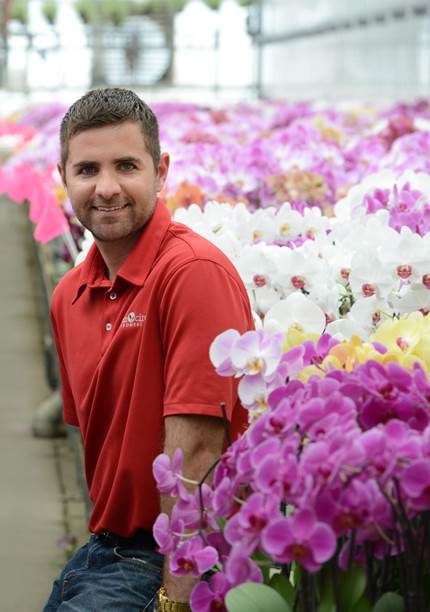
Best Young Grower, Renato Zardo’s approach to plant nutrition & water soluble fertilizers.
GrowerTalk selected Renato Zardo as the best young grower of 2015, calling him “focused and fearless.” Renato is Plant Health Manager for Green Circle, the large and successful Ohio-based grower with between 200 and 300 species under cultivation.
Renato takes care of the fertilizer recipes and is responsible for the overall health of each crop, which he achieves through IPM (integrated pest management). He works on research and development, running trials, the implementation of innovations, new product trials, as well as manages the in-house lab for soil and water analysis. He is also the bromeliads grower.
Renato explains that water testing is a constant task. “The water we use depends on the crop. On some we use city water on others RO (reverse osmosis) water or our pond water. We check the quality very closely, because it changes over time. The RO water is pretty consistent, but city water varies and we have found levels of boron and fluoride that can be dangerous for some crops.”
We asked him about his approach to plant nutrition. “We vary the fertilizer recipe according to the water tests,” he explains, “For instance this week if I’m getting 25 parts of magnesium on the city water and my target is 50, I’m only adding 30, but I’m sure that 2 months from now it will change and I should have for instance 35 parts, so I’ll only add another 15 parts. So we change our fertilizer recipe according to our source water.”
Some crops, like Anthurium and Bromeliad, are extremely sensitive to fertilizer changes. “They respond very well or poorly depending how we change the nutritional formulations,” he states, “So you have to be on top of that all the time.”
What is important in a water soluble fertilizer?
“It is very important that there is no contamination, because if we’re targeting two parts of iron we cannot have three or four because that would be toxic for the plants. It has to be extremely reliable, if the fertilizer bag states that it has 0.3% of copper and zinc, it has to have only that.”
“At one point we were buying a fertilizer that was not supposed to have any boron and we tested it and we find zero point zero something percent of boron and it was enough to damage the plants. Plant-Prod fertilizers are very pure, if they say something on the bag we know it is correct.”
Another consideration is how easy they are to mix. “We cannot mix for instance sulphur and calcium together because they will precipitate. They need to be easy to handle. A clear water soluble fertilizer is good so we can see if we have any precipitation on the bottom after mixing.”
Renato explains that plant productivity is not a matter of growing larger plants faster. “The most important thing for us is the visual impact. When customers are buying a flower or plant they are buying how it looks. They are not buying it based on the content of nitrogen, silicon, calcium or potassium in the leaves. If I’m testing a product that makes amazing roots but doesn’t change the visual appeal and doesn’t increase shelf life, it’s not worth it for us.”
Green Circle runs trials, where the shelf life of stressed plants is evaluated. For a silicon trial they have going right now, “Our goal is increase shelf life, we know silicon can do that if you build it overtime in the plant. How do you build silicon in the plant?” He asks, “You can do that in two ways: one way, by using the media that has silicon on the soil, the other way is applying overhead. It’s too risky for us to change the soil media as we don’t have enough knowledge about silicon to make that call for the whole company. So we took 100 pots of 9 and 12 inch hydrangeas, pink and blue, and we added the silicon soil on those plants, and compared them to the controls.”
“We apply the silicon up until 12 weeks then we set the crop. Then we brought the crop out of the greenhouse into the office to replicate the condition inside a house or store. We know we are looking for shelf life and so we see what performs best.”
Phytotoxicity is often a concern and it varies in the same species between varieties. “For instance we found that petunia purple doesn’t have a phyto, but petunia pink has phyto. Pink poinsettias are nice but red varieties show burn. For that reason, we always start on a small scale. Once there’s no burn then we run the main trial.”
Green Circle, much like other sophisticated growers, has many objectives including keeping labor costs under control. “Twenty or thirty years ago we would use a 200 gallon tank now we use 5,000 which cuts the time needed for mixing.”
The environment is another concern. “Phosphates cause algal bloom,” he explains, “Nitrates and sulfates are leachable migrating to the lower layers on the soil. The best way of avoiding runoff from the greenhouse is to make sure we’re only applying what the plant will take.”
Customized precision water soluble fertilizer solutions,
“We are careful to use the correct formulation for each growth stage,” states Renato, “For instance with bromeliads we change the levels of nitrogen and potassium from the growing phase to the maturing phase. We needed a custom formulation that Plant-Prod developed for us. It has been performing very well for us.”
